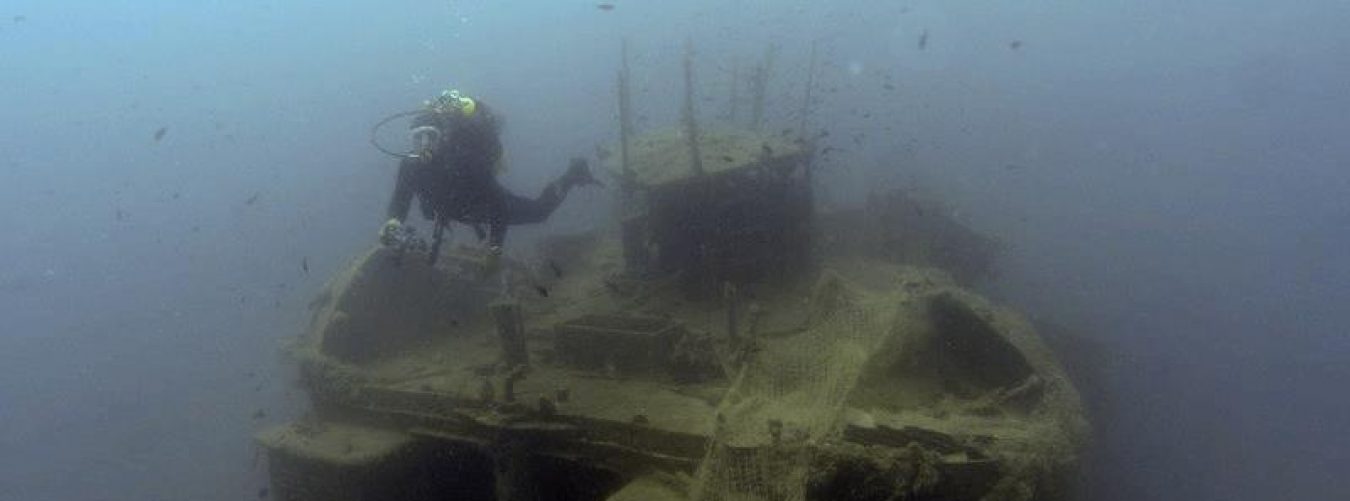On February 19th, 1758 the HMS Invincible set sail out of Portsmouth Harbor for Canada to join the British fleet to fight the French. Unfortunately, due to a domino effect of extraordinary bad luck, she ran aground on Horse Tail Sand not far from the harbor. Invincible was a French ship launched in 1744 and captured by the British in 1747. At that time the British out-number the French on the sea. The French compensated with a new 74 gun class built specially for speed and maneuverability. The Invincible was the first of this class and ‘state of the art’ technology of her day. While in the service of the Royal Navy her advantages were quickly recognized and she became the template that British ship design immediately began to emulated. Her maritime cultural significance, therefore, earned her a position on English Heritage’s list of 46 protected wreck sites in British waters. I had the privilege to dive her this week under the leadership of Dan Pascoe of the Nautical Archaeology Society, my advisor Dr. Fraser Sturt, and some of my maritime masters archaeology classmates. My personal objective was to attempt the first ever successful PTM file from a URTI dataset collected on an actual underwater archaeological site. To honor my instructor who taught me wooden boat part recognition, Dr. Julian Whitewright (of the HWTMA and University of Southampton CMA) I selected an Invincible ‘trenail’ to RTI.
Invincible’s outer planking is significantly thick; more resembling ‘timbers’ than planks. These huge planks were held to the frame timbers by cylindrical billets (‘trenails’) that were hand-hewn with a draw knife to a dowel shape, split at one end, and then driven with a mallet through a pre-bored hole that went clear through the planking into the frame member. Once the trenail was driven flush pinning the plank to the frame, it was then secured with a wedge of hardwood (usually English Oak) in much the same fashion an iron hammer head is secured to a Hickory handle.
Carrying a Fuji Finepix F200EXR auto-focusing underwater camera, a Bembo Trekker Mk3 tripod, a Diverite 15w 1000 lumen HID wreck diving light, and a Cultural Heritage Imaging RTI reflectance ball on the end of a threaded rod, Amy Astley (PhD student studying the taphonomy of historic shipwreck sites with the University of Southampton’s Department of Ocean and Earth Science ) and myself exited the stern of the Shogun (http://www.msdsmarine.co.uk/) into the 16c water of the Solent and made our way to a part of the wreck that has a large section of exposed planking. It did not take long to locate a trenail and setup up for its URTI dataset capture. In c. 8 meters of water with a southeasterly rising tide bringing dirty water in from the Solent at a rate of half a knot (approximately 1 foot per second), I struggled to stay in position while making this data capture. A half knot current is enough to gently blow an inexperienced diver off the site. I was entirely surrounded by smooth planking and even though I wore extra lead weight to help keep me down for the task, it was all I could do to hold onto an archaeological marker tag with one finger and freehand the light positions with the other hand. Periodically, I had to pause while debris passed by or momentarily got stuck on the trenail. In the end, and much to our amazement the camera did not move and the capture was a success.
These JPEG images are screen captures from the first ever PTM file generated from an underwater archaeological field environment. This trenail has been submerged for 255 years. It is c. 3 cm diameter. You can easily discern the longitudinal grain patterns of the wedge, the radial grain pattern in the trenail, and the clear signs of site degradation from marine wood boring micro-organisms on a surface that Dan Pascoe testifies was ‘prestine, just one season ago.’ A big thank you to Amy, the crew of the Shogun, Dan Pascoe, Dr. Sturt and my classmates for a fantastic and memorable day of diving. One more small step forward for URTI.



Location of HMS Invincible
